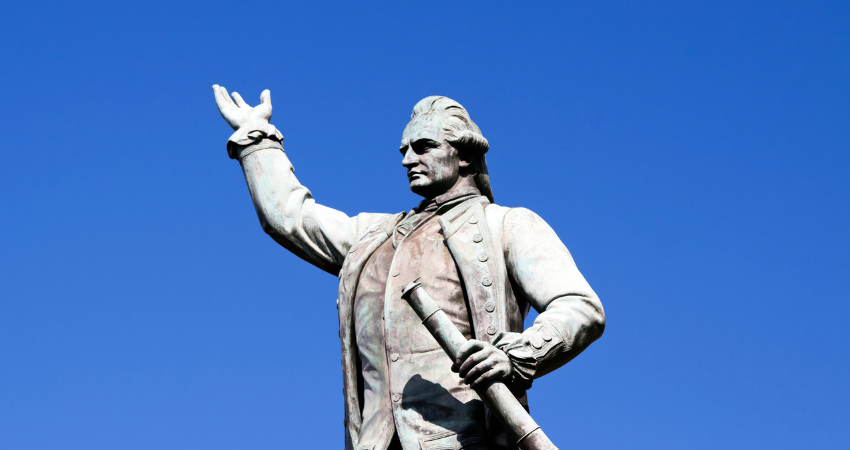Review: Warra Warra Wai, Darren Rix and Craig Cormick, Scribner and The Wide Wide Sea, Hampton Sides, Penguin
In Australia (and elsewhere) Captain Cook is a disputed and contentious figure, a target of abuse and respect, polarisation of attitudes coming to the fore on Australia Day. These two books explore Cook’s relations with Indigenous people across the Pacific, a topic that continues to be argued over. Though a symbol of colonisation and a reflection of his prejudiced times, Cook is also seen as somewhat distanced from the colonial enterprise, preferring the joy of discovery and exchange of knowledge.
Warra Warra Wai looks at Cook’s journey up the east coast of Australia on his first Pacific voyage, refreshingly taking the perspective of Indigenous peoples, noting primarily how sites Cook named already had names and long histories. (I doubt there is any book out there currently that displays better the richness and variety of Indigenous connection with the land.)
The Wide Wide Sea looks at Cook’s third voyage, especially his relationships with people in Tahiti, New Zealand, Hawaii and the Pacific coast of North America, and how Cook’s attitude to Indigenous people, as well as his hubris, had developed, before his return to Hawaii and his death.
That Cook was a skilled mariner and mapmaker is undisputed. Crews were in awe of his experience, calm, decisiveness and ingenuity. He pioneered the prevention of scurvy and successfully utilised a new invention, the chronometer, which revolutionised global positioning. He wasn’t interested in grandiosity, a trait perhaps inherited from his Quaker family. His journals are largely devoid of judgements on non-Western people, unlike other contemporary accounts; he was matter-of-fact but curious about places and people he encountered.
Partly because of his reticent nature we know little of his innermost thoughts. This is not helped by the fact that his wife burned his letters to her after he died. But because of this, it is difficult to ascertain his intentions and beliefs.
By the third voyage though, some hubris and complacency had crept in, possibly because of illness or fatigue, culminating in the strange events and his murder in Hawaii. In New Zealand, the Maori assumed he was there to avenge the deaths of sailors from a sister ship on his previous voyage. His reluctance to enact revenge or even justice confused his men and the Maori alike. But Hampton Sides thinks Cook was more understanding of violence within the societies he encountered and understood that the presence of the English also encouraged violence. After New Zealand, says Sides, Cook became less optimistic about cross-cultural exchanges and gave the American colonies as evidence of how colonisation could not avoid calamity, especially on the native side.
It seems Cook was beginning to understand that his explorations were leading to a sad inevitability – what James Morrill, a white man who lived with Indigenous people in the Townsville area after a shipwreck, quoted in Warra Warra Wai, told Indigenous people there: simply that white people were coming to take their land, and they couldn’t stop them.
Sides notes that Cook never tried to evangelise Christianity, though he did encourage Tahitians to grow English-style gardens, and in Tasmania he thought Tasmanians would benefit from pigs being released into the wild. In Tahiti, Cook’s gardening evangelisation was odd, and it seems Tahitians thought so too, as it was obvious Tahitians ate better, and were healthier, than Cook and his men (and the English more generally).
There was conflict internally with Cook’s attitudes. Keen observation was challenging entrenched ideas about the supposed superiority of English civilisation. The Maori were desperate for iron, seeing its technological superiority. But Cook noted that Indigenous Australians were indifferent to English tools and yet wanted for nothing. By the time he reached Cape York on his first voyage, Cook had decided Indigenous Australians were happier without the baggage of English culture. One wonders then, when he claimed Australia’s east coast for the English, whether he was just doing his duty and was beginning to question the point of it. Sides says that once Cook got to Canada on the third voyage there is evidence he was sick of the ‘absurd’ ritual of planting the English flag wherever he went.
(Rix and Cormick remind us that, technically, Cook’s Australian claim was illegal, as he was instructed to claim the land with the consent of the locals, something that clearly was not obtained. But perhaps he knew that permission was just a courtesy to be discarded if need-be, and that he was expected to claim the land in any case. In one sense, this is what happened later anyway.)
Cook decided that a Polynesian man, Mai, who travelled with them to England would’ve been better off having never encountered the English. This would seem to go for non-human species too – Cook’s encounter with sea otters off the Canadian coast would set off a hunting frenzy that would be catastrophic for the animals.
In Dix and Cormick’s book, Cook is criticised, understandably, for naming Australian landmarks after the English. But Sides says he did, on occasion, try to learn Indigenous names (perhaps a development in his later voyage). But in Australia most Indigenous people steered clear, so he never had the opportunity.
There are deeper questions here about Indigenous connection to land and how that was perceived. The English were blind to many of these connections, but the observant Cook should have understood that the land was not terra nullius. And his presumption to (re)name the land had implications later for the suppression of Indigenous culture and rights. Warra Warra Wai shows repeatedly how the imposition of English names helped lead to the assumption that the English had a right to take the land.
Cook did show some interest in local cultural protocols, difficult as they were at times to ascertain. But this could easily come undone, as when, off the coast of Far North Queensland, his crew took too many turtles, an outrage to local people who carefully managed turtle numbers. At root was a clash of cultural perspectives – one preservationist, one exploitative, a clash that undoubtedly stains Australian history right up to the present.
Cultural clashes are at their most intriguing and escalated in the case of Cook’s (fatal) return to Hawaii. Just what went on here is hotly debated. In Hawaii Cook encountered a people with a culture that had been isolated for hundreds of years. Where before there had been cultural exchange between Hawaii and other parts of Polynesia (despite the incredible distances), the Hawaiians had since lost contact. When he returned to Hawaii the locals were not used to visitors, and Cook arrived at just the right time – in the middle of an ecstatic religious feast. The tens of thousands who had gathered received Cook as a god, the ship and its sailors coinciding with local mythology about the return of a god.
Or at least that is how it seemed – there is great debate as to whether everyone believed Cook was a god. Indigenous Australians initially thought the English were some sort of supernatural phenomenon, but when they broke cultural protocols repeatedly, the locals started having doubts. (Certainly, the English were curiosities – on his first visit the Hawaiians had thought Cook’s clothes were his skin, and that his body had built-in pockets from which he produced confusing treasures.) Cook went along with it to an extent, later attracting, posthumously, criticism from English clergy for being heretical and encouraging paganism.
Sides’ book shows what happened to turn the adulation into ferocity, leading to Cook’s death. Local mythology played its part, but so did Cook’s miscalculations, the exploitative assumptions of the English and the fragility of the cultural encounter. Sides notes that it is a wonder Cook wasn’t killed earlier, considering how many similarly tricky encounters he had to negotiate, but it seems earlier successes had created in Cook a feeling of impunity that would be his undoing in Hawaii.

Indigenous Australians have varying takes on Cook, with one, in Rix and Cormick’s book, saying that at least Cook told England about Indigenous people, unlike Banks, who was largely indifferent to people, black or white. Some are grateful that Cook, indirectly, brought the Gospel, despite the entanglement of church and state and what trouble that brought. But it is also understandable that Cook would be a symbol, perhaps at times unfairly, for the disasters he, perhaps reluctantly, initiated.
Nick Mattiske blogs on books at coburgreviewofbooks.wordpress.com and is the illustrator of Thoughts That Feel So Big.











